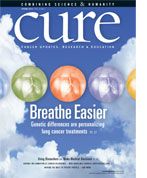Publication
Article
CURE
Making the Most Out of Your Patient Portal
Author(s):
Online access to your medical records can be a valuable asset, but shouldn't replace doctor-patient communication.
In the nearly nine years since he received a diagnosis of stage 4 head and neck cancer, Ed Steger has experienced a sea change in his ability to access his medical records online.
During the first years following his 2005 diagnosis, as he weathered a battery of treatments that included three major surgeries, 36 radiation treatments and seemingly endless cycles of chemotherapy, the medical records office became a routine stop during each visit to Houston’s MD Anderson Cancer Center. The paperwork accumulated, filling three hefty binders, which he no longer needs to reference.
Instead, Steger can tap a few computer keys and review everything from lab and imaging test results to the notes dictated by his doctors following each visit. These days, after the radiologist calls Steger to discuss his latest round of imaging scans, the 62-year-old Houston resident further reassures himself by reviewing the news online.
“I want to make sure that everything is how I heard it,” says Steger, who’s been cancer-free since late 2007. “It’s kind of a check and balance that I have.”
Once a rarity, this level of online access, through what’s typically dubbed a patient portal, has become more common in the last few years. Increasingly hospitals and doctors’ offices are adopting these portals, protected by passwords and other security measures, so patients can do more than simply schedule their next appointment. Depending on the facility, patients can request a medication refill, check test results or sift through the nitty-gritty of their physician notes. Steger recounts how he’s even downloaded key details of his medical record to help resolve an insurance coverage dispute.
“At times, it’s a really good thing,” says Mikkael Sekeres, a physician who directs the leukemia program at Cleveland Clinic in Cleveland. “I’ve had patients who emailed or texted nurses with pictures of a rash to say, ‘What should I do about this?’”
But some clinicians also worry about unintended consequences for patients with serious illnesses such as cancer, most notably that their untrained view of a test result or physician comment could cause undue anxiety.
“Lab results and radiology results can be indicators of new disease or progression of disease,” says Elizabeth Rodriguez, a nurse leader at New York’s Memorial Sloan-Kettering Cancer Center who has been closely involved with its portal rollout. “That’s different from going online to look at your cholesterol tests.”
With most patient sites, users can view, via a secure online door or portal, their personal medical information from the comfort of a computer or mobile device. Roughly 50 percent of U.S. hospitals already deploy some degree of portal technology, although, in some cases, patient access is still being developed, according to a recent report by global consultant Frost & Sullivan.
The portal can help bridge the miles between doctors or family members. Patients might be able to provide caregivers access to their portal, to keep them in the loop.
[Read how to keep your medical information secure]
Another advantage when the doctor’s notes are available: patients can review the summary after an information-packed and sometimes emotional visit, says Tom Feeley, the physician who heads up MD Anderson’s Institute for Cancer Care Innovation and collaborated on the portal’s development. “A lot of our patients have told us that what they really value [about] being able to go back and read the doctor’s note is to be able to reinterpret what they heard with what someone has written down and really process things,” he says.
The type of information cancer facilities make available and the time involved in getting it posted online can vary significantly. MD Anderson holds all results—lab work, imaging and pathology reports—for seven days, giving clinicians the opportunity to discuss any worrisome findings with the patients first, Feeley says. Similarly, Cleveland Clinic’s Taussig Cancer Institute gives physicians time to discuss information with patients before posting, with the maximum delay being two business days for lab work, 10 for imaging scans and 20 for pathology results.
Memorial Sloan-Kettering provides lab work immediately but builds in a lag of three full business days for imaging results, Rodriguez says. “Our aim is to show the patients as much of their medical record in real time as possible,” she adds, noting that, after all, it’s the patient’s information. The time frame, she continues, was carefully considered to balance the needs of patients with the concerns of clinicians, who were worried that imaging results might require more explanation.
Consider a patient whose lung cancer is in remission who reads a radiologist’s report that describes the detection of a new 1-centimeter nodule on a recent scan, she says. The patient could overreact, convinced that the cancer has recurred. “It may have,” Rodriguez says. “It may not have. It could be something as simple as the patient’s positioning during the scan. It could be an infectious process and not related to the cancer.”
Still, because some lab results are never even communicated to many patients, the Department of Health and Human Services issued a ruling in February that requires clinical laboratories to provide patients direct access to their own test results within 30 days of receiving a request.
As portals become more common, clinicians are envisioning other uses—benefitting both doctors and patients. Cynthia Tankersley, a nurse and clinical director of survivorship services at the West Clinic in Memphis, Tenn., says patients have been involved in an upgrade of its portal that includes a 90-item symptom survey, the results of which can help physicians identify a patient’s most significant concerns and allow discussion of sensitive subjects, such as sexual dysfunction and other psychosocial issues. Caregivers, who are often best positioned to monitor any changes in symptoms over time, can assist patients with the survey, which can be easily accessed through the portal or on various mobile devices.
I think most people respect boundaries with clinicians. I worry more that patients will be emailing serious medical questions that really deserve a phone call.
MD Anderson also intends to use its portal technology to more closely monitor not only symptoms, but also treatment results, Feeley says.
For example, information obtained through the portal could help clinicians better ascertain a man’s ability to return to normal sexual function after surgery for prostate cancer or a woman’s level of satisfaction with breast reconstruction.
As portals proliferate, one worry is that patients will become too dependent on interacting with pixels rather than people. Consider email, which should be strictly confined to nonurgent situations, Sekeres says. “I think most people respect boundaries with clinicians,” he adds. “I worry more that patients will be emailing serious medical questions that really deserve a phone call.”
Patients also should consider their own emotional stamina before delving too deeply into their online information, the leukemia specialist adds. As it happens, Sekeres doesn’t check his own test results through the Cleveland Clinic’s portal. “I’d rather discuss it with my doctor and have it be placed in context.”
Portal services give patients access to medical records, but some test results could be misinterpreted.
That reticence extended even to a potential medical crisis this past year, when an ultrasound of his heart initially appeared to show evidence of an earlier, silent heart attack. In an essay Sekeres wrote for The New York Times, he describes walking in his patients’ shoes as he coped with the stress of waiting for days until further tests determined that the first scan was technically flawed, and his heart was given the all-clear.
Did Sekeres sign on to the portal while suffering through that medical limbo? Nope, he says. He waited until he could speak with his cardiologist.





